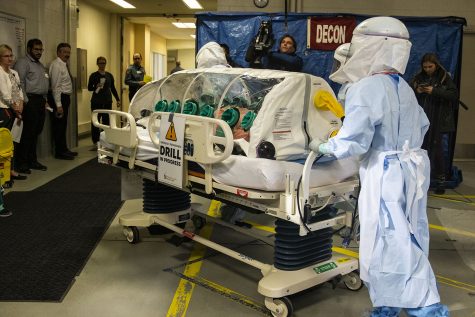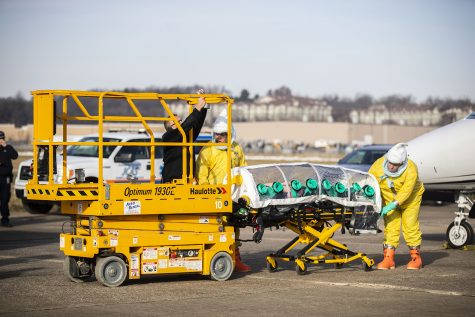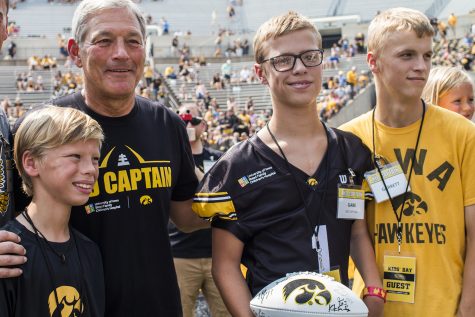UIHC exercise simulates hazardous disease response
UIHC put their abilities to the test in an emergency response exercise for bio-infectious disease at the airport and emergency room Tuesday.
UI Hospitals and Clinics holds an emergency response exercise at the UIHC Ambulance Bay on Tuesday, Dec. 11, 2018. The goal of the response exercise was to prepare for use of the biocontainment unit.
December 11, 2018
At a preliminary drill on Tuesday, the University of Iowa Hospitals & Clinics tested its ability to respond to a “suspected emerging bio-infection,” receiving a patient at the Iowa City Municipal Airport and transporting her to the UIHC emergency room to identify the disease and begin treatment.
In an effort to make the simulation seem as real as possible, UI Health Care communications specialist Molly Rossiter released a mockup media statement outlining the details of the patient’s arrival and condition.
“The safety of our patients, staff, and community are our highest priority,” Rossiter said. “We are working with the Iowa Department of Public Health and Johnson County Health to ensure the health and safety of everyone.”
RELATED: Photos: UIHC Emergency Response (12/11/18)
She reminded readers that the disease in this exercise was unknown; if a similar, real emergency were to occur, measures would be immediately taken to prevent the spread of disease.
UIHC emergency-management coordinator Mike Hartley said this was the first drill at the airport, and the hospital’s priority was to simulate loading and unloading the patient from the aircraft, transferring her to the emergency room, and decontaminating the ambulance afterwards.
“This is a practice to work out the logistics of dealing with an aircraft,” Hartley said. “We hope we never have to open up our biocontainment unit; we just want to make sure we’re ready.”
The exercise was requested by UIHC federal partners in Kansas City to see what it would be like to transport a patient from a small, municipal airport such as Iowa City’s to the ER.

UI Hospitals and Clinics holds an emergency response exercise at the UIHC Ambulance Bay on Tuesday, Dec. 11, 2018. The goal of the response exercise was to prepare for use of the biocontainment unit.
“We learned some things about how to make that a little smoother,” Hartley said. “We now know the scissor lift is high enough to unload the patient, but we’d like to see a wider platform. I think the bottom line is the interaction between the ambulance crew and our staff is important.”
As a Tier 2 institution, the UIHC special isolation unit is reserved as backup to its Region 7 counterpart University of Nebraska, a Tier 1 institution and veteran in treating such hazardous diseases as Ebola.
“I think one of the most important things about this is that these are very rare events,” Hartley said. “The whole key to biocontainment care is that we’re able to do it, but we’re able to do it so there’s absolutely no risk to everyone else in the hospital.”
For Tuesday’s drill, the hypothetical patient was a UI student returning from a South Asian mission, having contracted an unknown virus. She was contained in a special capsule to keep the community safe, and the ambulance was thoroughly disinfected after her arrival at the ER.
Although Hartley said the likelihood of an emergency of this nature is slim, he emphasized the need for training and working with experts nationwide to make sure UIHC is equipped with suitable research, protocol, and personnel.
“You have to practice and continue to practice, do it over and over again,” Medic EMS fleet communications manager Jeremy Pessman said. “You need to basically be able to do it in your sleep.”























